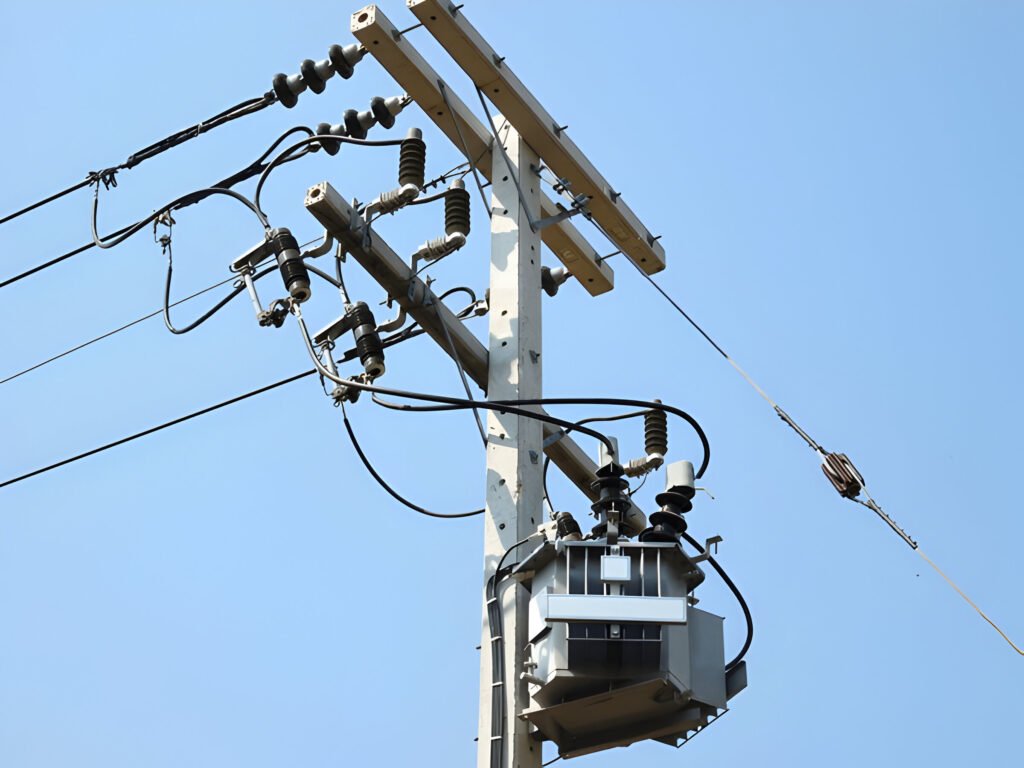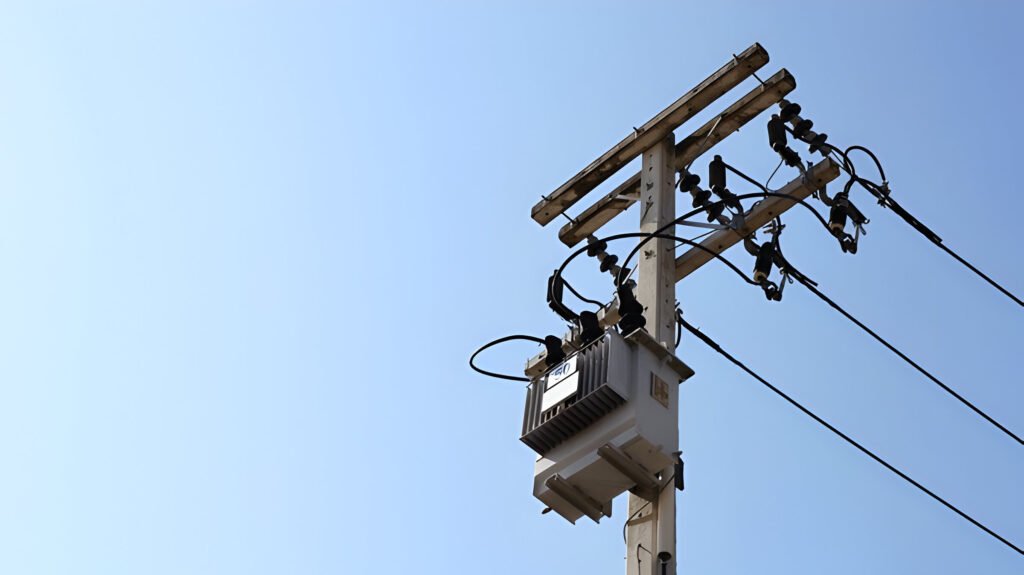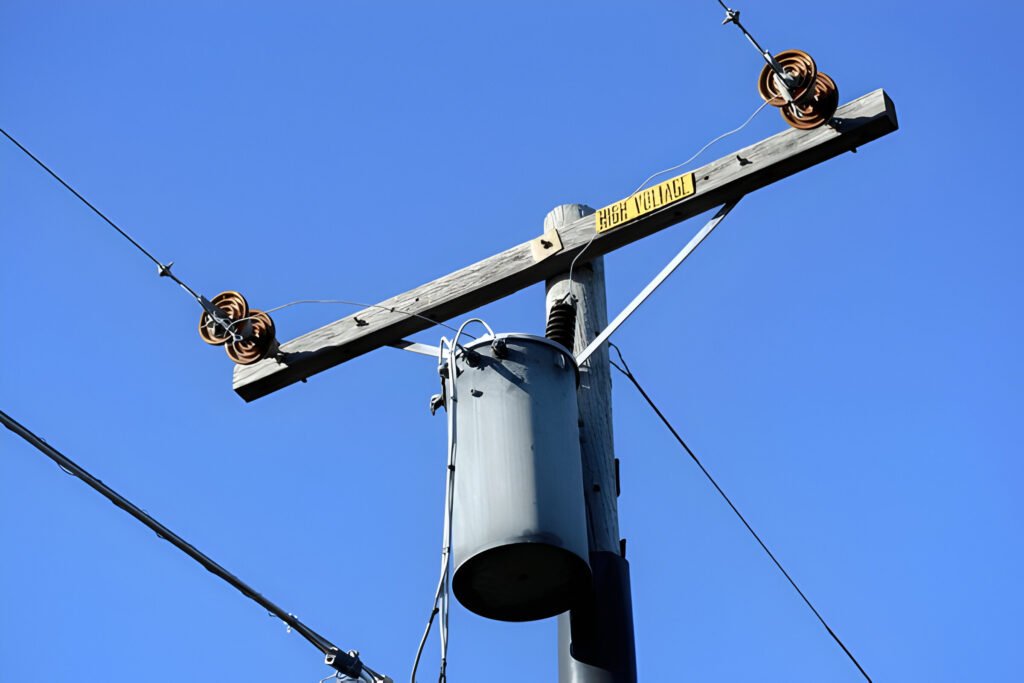What Is All Day Efficiency in Distribution Transformers
All day efficiency measures a distribution transformer’s average efficiency at varying load levels over 24 hours.
Read More
A telephone pole transformer, also known as a utility pole transformer or distribution transformer, is a device mounted on utility poles that steps down high-voltage electricity from power lines to a lower voltage suitable for residential and commercial use. These transformers play a crucial role in the electrical grid by safely and efficiently delivering power to homes and businesses.
Telephone pole transformers typically consist of a core, primary and secondary windings, insulation, and a protective enclosure. They work on the principle of electromagnetic induction, converting high-voltage alternating current (AC) from the power lines to a lower voltage that can be safely used by consumers.

A telephone pole transformer, also known as a pole-mounted transformer, is a critical component of the electrical distribution system. These transformers are commonly mounted on wooden poles or concrete poles along utility pole routes. Their primary function is to step down high-voltage electricity from primary distribution wires to a lower voltage suitable for residential and commercial service drops.
The voltage power handled by telephone pole transformers varies depending on the specific distribution system. Common primary voltages include 7,200 volts, 12,000 volts, and 34,500 volts, which are then stepped down to standard secondary voltages such as 120/240 volts for residential service and 120/208 volts or 277/480 volts for commercial service.
Telephone pole transformers are engineered to withstand the elements and potential hazards, such as lightning strikes and electrical faults. They are equipped with protective devices like surge arresters and fuses to minimize damage and ensure safe operation. Some transformers, known as completely self-protected (CSP) transformers, have built-in protective features for added safety and reliability.
The transformer consists of two sets of coils: the primary coil and the secondary coil. The primary coil receives the high voltage power, typically ranging from 4,800 to 13,200 volts, from the primary distribution wires on the upper portion of the utility pole. As the electric current flows through the primary coil, it creates a magnetic field that induces a lower voltage current in the secondary coil.
The secondary coil is designed to output a lower voltage, usually 120/240 volts for single-phase transformers or 120/208 volts for three-phase transformers, which is suitable for powering homes and small businesses. The transformer’s core, made of laminated steel, helps to concentrate and direct the magnetic field, ensuring efficient energy transfer between the coils.
Single-phase transformers are the most common type used for residential and small commercial service drops. These cylindrical transformers are mounted on wooden poles or concrete poles and convert primary voltage to secondary voltage suitable for customer use.
Three-phase transformers, also known as transformer banks, are used for larger commercial and industrial loads. These transformers consist of three single-phase units connected together to provide higher power capacity and voltage regulation. Three-phase transformers are typically mounted on taller poles or dedicated poles to accommodate their size and weight.
Oil-cooled transformers use transformer oil as an insulating and cooling medium.
Dry-type transformers rely on air circulation for cooling.
Utility poles carry various wires and cables that serve different purposes, from providing electrical service to supporting communication lines. To identify these wires, it’s essential to understand their positioning and appearance on the pole.

The amperage of a telephone pole transformer varies depending on the specific transformer’s capacity and the loads it serves.
Typical pole-mounted transformers have capacities ranging from 5 kVA to 500 kVA, with some larger units reaching up to 2,500 kVA for heavy industrial loads. The amperage of these transformers is determined by their kVA rating and the secondary voltage they provide to the customers.
For example, a common 25 kVA single-phase transformer with a 120/240V secondary voltage can supply up to 104 amps at 240V or 208 amps at 120V. A larger 100 kVA three-phase transformer with a 120/208V secondary voltage can provide up to 277 amps per phase.
Typically, pole transformers receive primary voltage from overhead wires ranging from 4,800 to 34,500 volts. The most common primary distribution voltages are 7,200, 12,470, 13,200, and 13,800 volts. These high voltages allow for efficient long-distance transmission of electricity while minimizing power losses.
Once the high-voltage electricity reaches the pole transformer, it is stepped down to a secondary voltage, usually between 120 and 480 volts. For residential service drops, the standard secondary voltage is 120/240 volts, which is then supplied to homes and small businesses via service wires.
In a three-phase system, commonly used for larger commercial and industrial loads, the pole transformers may output higher secondary voltages, such as 208Y/120 volts or 480Y/277 volts. These transformers have three sets of windings to accommodate the three phases, ensuring a balanced and efficient power supply.

Typically, a single-phase pole-mounted transformer contains between 40 to 100 pounds of copper, while larger three-phase transformers can contain up to 500 pounds or more.
Single-phase pole-mounted transformers typically weigh between 100 to 500 pounds, while three-phase transformers can weigh up to 1,000 pounds or more.
In most cases, replacing a pole-mounted transformer takes between 4 to 8 hours. This timeframe includes the preparation work, such as setting up safety measures, coordinating with the utility company for power disconnection, and gathering the required tools and equipment. The actual replacement process involves removing the old transformer, installing the new one, and reconnecting the primary and secondary wires.
However, the replacement time can be longer if complications arise, such as discovering damaged or outdated components that need to be replaced alongside the transformer. Additionally, if the pole itself is in poor condition, it may need to be replaced entirely, which can extend the overall timeframe to several days.
To minimize service disruptions, utility companies often schedule transformer replacements during off-peak hours or on weekends.
Pole-mounted transformers are generally safe when properly installed, maintained, and operated according to industry standards and regulations. These transformers are designed with multiple safety features to minimize risks to the public and utility workers.
Single-phase transformers, which are commonly used for residential and small commercial loads, typically range from $1,000 to $3,000. Three-phase transformers, designed for larger commercial and industrial applications, can cost between $5,000 and $25,000 or more.
In addition to the transformer itself, installation costs must also be considered. These expenses include the pole, hardware, and labor required to mount the transformer and connect it to the distribution lines. The average cost for installing a pole-mounted transformer ranges from $2,000 to $10,000, depending on the complexity of the job and local labor rates.